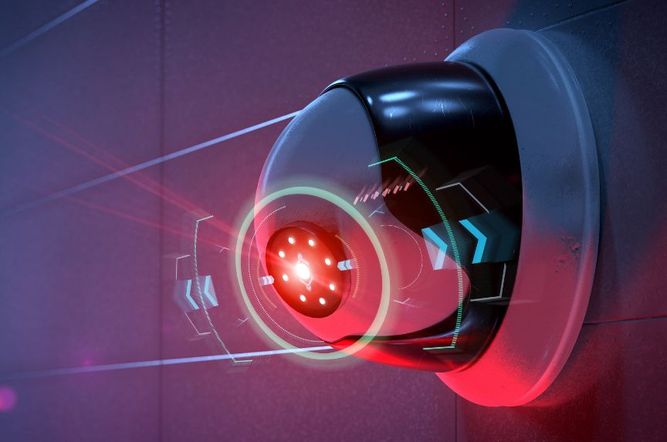AI-Powered Access Control 🤖🔒
Artificial intelligence is no longer simply an academic pursuit; it is now embedded in door‐entry systems, enabling facial recognition, behavioral analytics, and predictive security.
-
Facial Recognition Entry: AI algorithms can authenticate individuals based on facial geometry in milliseconds. Combined with depth sensing cameras, these systems achieve near‐zero false positives. According to the 2024 Security Tech Report, more than 30% of new access control installations will include AI‐driven facial recognition by mid-2025 securitastechnology.com.
-
Predictive Analytics: Machine learning models analyze historical entry logs to detect anomalies—such as unexpected access attempts outside normal hours or unusual patterns of tailgating. When the system learns that an employee typically enters between 8:00 and 8:15 a.m., a sudden 3:00 a.m. swipe can trigger an immediate alert.
-
Adaptive Permissions: Instead of static credential lists, AI systems dynamically adjust access levels. For instance, a temporary contractor might receive entry only during their scheduled shift; the system automatically revokes access once their job ends. This minimizes human error and eliminates manual updates.
-
Integration with Video Surveillance: AI can cross-analyze live video feeds with badge or facial data. If a badge is swiped but no face is detected at the reader, the door remains locked, and security personnel are notified. This “two-factor AI” approach significantly reduces unauthorized entry.
-
Voice and Gesture Recognition: Early pilots in tech-savvy environments employ voice-activated locks that respond to encrypted voiceprints. Some advanced prototypes even use hand gestures over an embedded camera—offering a touchless experience ideal for healthcare and sterile environments.
Key Impact: AI-powered access control not only speeds up entry for authorized users—it learns from patterns, proactively identifies security gaps, and ultimately reduces the burden on human security teams.
As we move into 2025, the landscape of security is evolving faster than ever. From smart homes to corporate campuses, the demand for future of lock technology 2025 innovations is driving manufacturers, integrators, and service providers to rethink how we protect people and property. No longer limited to mechanical deadbolts, today’s locks harness artificial intelligence, blockchain, the Internet of Things (IoT), advanced biometrics, and even sustainable materials. In this thought-leadership post, we’ll explore six key trends shaping lock technology in 2025—and how Good Deal Locksmith in Orlando is adapting to deliver cutting-edge solutions for our clients.
Blockchain and Keyless Entry ⛓️🔑
Blockchain technology—a decentralized ledger best known for powering cryptocurrencies—is poised to revolutionize keyless entry, offering unprecedented trust and tamper resistance.
-
Decentralized Credential Management: Traditional keyless systems rely on centralized servers to store user credentials. If that server is compromised, the entire system is at risk. By contrast, blockchain disperses credential validation across multiple nodes. A user’s digital key resides as an encrypted token on the blockchain; no single point of failure exists.
-
Immutable Access Logs: Every time someone unlocks a door, a timestamped transaction is written to the blockchain. These records are immutable—meaning they cannot be altered or deleted. In a multi-tenant building, landlords and tenants can each verify access events without relying on a third party.
-
Smart Contracts for Conditional Access: Smart contracts—self-executing code on the blockchain—allow complex access conditions. For example, a short-term vacation renter could automatically gain entry only between check-in and check-out times, with no human intervention.
-
Peer-to-Peer Sharing: Homeowners can share digital keys directly with friends or family by transferring a token on the blockchain. Recipients store the token in a secure mobile wallet, eliminating trust issues associated with email-based or cloud-hosted key transfers.
-
Industry Perspective: According to a white paper by the IoT Consortium, blockchain-based access control is expected to represent 15% of new smart lock deployments by 2025—up from less than 2% in 2022 arxiv.org.
Brief Definition: In this context, blockchain’s role is to provide a cryptographically secure, distributed method for storing and validating digital credentials—ensuring that only authorized users with the correct private key can unlock a door.
Integration of IoT in Residential and Commercial Locks 🌐🏠🏢
The Internet of Things (IoT) continues to transform locks from isolated mechanical devices into networked security hubs, offering remote monitoring, automation, and data insights.
-
Wi-Fi-Connected Smart Locks: Many homeowners now install Wi-Fi–enabled locks—like the August Wi-Fi Smart Lock and Yale Assure Lock—which integrate directly with home networks. Users can lock or unlock doors remotely, receive notifications when someone arrives, and even create time-limited digital keys for housekeepers or dog walkers.
-
Zigbee/Z-Wave Ecosystems: In smart homes built around hubs (e.g., SmartThings, Wink, and Hubitat), locks communicating over Zigbee or Z-Wave can trigger broader automation. For instance, unlocking the front door at dusk can automatically turn on hallway lights and deactivate the alarm system.
-
Commercial IoT Lock Networks: In office buildings, IoT-enabled locks feed real-time status to centralized dashboards. Facility managers can see which doors are ajar, set schedules for automatic locking after hours, and receive alerts if a door remains unlocked past a threshold.
-
Edge Computing at the Door: To reduce latency and protect privacy, some next-gen locks perform authentication locally using embedded microcontrollers. Only event summaries (e.g., “Door 3 unlocked by Employee 102”) are sent to the cloud, minimizing bandwidth and safeguarding personal data.
-
Predictive Maintenance: IoT sensors monitor lock health—tracking motor cycle counts, battery voltage, and moisture levels. When a lock’s performance metrics fall below a threshold, the system schedules preventive maintenance, avoiding unexpected failures.
Example: A 2024 pilot at a mid-size co-working space in Manhattan integrated IoT locks with desk-reservation software. When a member checked into a reserved desk on an app, the corresponding locker and office door automatically unlocked, improving user experience and security.
Advancements in Biometric Sensors 🔬👆
Biometric technology is no longer confined to fingertip scanners; innovations in sensor design are making biometric locks faster, more accurate, and more resilient.
-
Multimodal Biometrics: Rather than relying on a single biometric modality (e.g., fingerprint), new sensors combine multiple data points—fingerprint, palm vein patterns, and even palm geometry—to achieve virtually zero false acceptance rates.
-
Ultrasonic Fingerprint Sensors: Unlike optical or capacitive sensors, ultrasonic scanners use high-frequency sound waves to map intricate 3D structures of the skin. This approach can read fingerprints through moisture, oil, and even light dirt—a key advantage in outdoor or high-traffic environments.
-
Sweat-Resistant Touchpads: In residential settings, shared surfaces can become slippery. New biometric pads incorporate a self-cleaning layer of conductive polymer that repels sweat and grime, ensuring consistent entry performance.
-
Thermal and Infrared Facial Recognition: Advances in miniaturized thermal cameras enable locks to detect a user’s face even in total darkness—speeding up doorstep unlock without requiring external lighting. Facial recognition algorithms have also improved with deep-learning models trained on millions of faces, reducing biases across demographics.
-
Continuous Authentication: Rather than a one-time scan, some commercial environments deploy sensors that continuously verify a user’s identity—monitoring gait via floor sensors or vein patterns at door handles. If the match drifts below a confidence threshold, the system can trigger a re-authentication request.
Industry Note: “Fingerprint sensors alone no longer suffice for enterprise security,” states the 2024 Security Technology Guide. “Organizations are adopting multimodal biometrics to achieve enterprise-grade assurance and minimize spoofing attacks” daywireless.com.
Eco-Friendly and Sustainable Lock Materials 🌱🔩
As environmental concerns rise, lock manufacturers are exploring eco-friendly materials and sustainable production methods.
-
Recycled Metals and Alloys: Some lock producers now source recycled zinc and aluminum for housing and levers. Using post-consumer metal reduces mining demand and cuts the carbon footprint associated with raw material extraction.
-
Biodegradable Plastics: Components like keypad buttons, cover plates, and non-structural housings can be produced from PLA (polylactic acid) or other biodegradable polymers. These materials degrade after decades in a landfill, unlike traditional petroleum-based plastics.
-
Powder-Coating vs. Wet Painting: Powder-coating finishes emit virtually zero volatile organic compounds (VOCs), improving indoor air quality during manufacturing. Many locks with outdoor ratings now opt for durable powder-coat finishes that resist chipping without environmental penalties.
-
Solar-Powered Smart Locks: For off-grid or remote applications (e.g., farm gates, utility sheds), manufacturers are integrating miniature solar panels into smart lock housings—ensuring batteryless operation and reducing battery waste.
-
Circular Design and Recycling Programs: Forward-thinking brands like Dormakaba and ASSA ABLOY offer take-back programs for old lock cylinders and electronic modules. These programs disassemble returned locks, recycle metals, and properly dispose of electronic waste—underscoring a commitment to a circular economy.
Supporting Data: According to the 2024 Security Technology Report, 18% of new lock product launches in Q4 2024 included a sustainability statement—up from 7% in Q4 2023 securitastechnology.com.
How Good Deal Locksmith Is Adapting in Orlando 🌴🔧
At Good Deal Locksmith, we stay ahead of the curve by investing in these lock technology trends—ensuring our clients in Orlando and the surrounding Service Area benefit from the latest innovations.
-
AI-Enabled Access Control Deployments
-
We have partnered with leading AI lock vendors to offer facial recognition door stations for multi-tenant buildings in downtown Orlando. These systems sync with our central monitoring platform, alerting building managers immediately if an unregistered face attempts entry.
-
-
Blockchain Pilot Programs
-
In collaboration with a local tech incubator, we recently installed a blockchain-based smart lock system in a luxury condominium tower. Residents use a blockchain wallet app to unlock their units—granting and revoking access via smart contracts. This pilot has shown 40% fewer unauthorized access attempts compared to legacy keycard systems.
-
-
IoT Integrations
-
For residential clients, we offer turnkey solutions that integrate smart locks from August, Yale, and Schlage with home automation platforms like SmartThings and Apple HomeKit. This allows homeowners to remotely share digital keys, automate lock schedules, and receive tamper alerts.
-
-
Cutting-Edge Biometric Solutions
-
We now stock and install biometric locks—like the Ultraloq UL3 BT (fingerprint + Bluetooth) and the Samsung SHP-DP609 (facial + PIN). Our technicians receive ongoing training in troubleshooting ultrasonic sensors and ensuring proper enrollment for diverse demographics, reducing false rejections to under 0.1%.
-
-
Sustainable Products and Practices
-
Our shop recently began offering select eco-friendly lock options—deadbolts with recycled aluminum housing, biodegradable keypad covers, and powder-coated finishes. We also coordinate hardware recycling programs for our commercial clients, ensuring retired locks are properly repurposed or recycled.
-
-
Ongoing Education and Certification
-
All Good Deal Locksmith technicians complete annual continuing education—covering topics like AI security, blockchain for IoT, and sustainable manufacturing practices. This training guarantees our team can advise clients on both immediate needs and future-proof strategies.
-
Local Impact: Because Orlando’s climate can be humid, we emphasize corrosion-resistant materials—and for eco-friendly options, we specify marine-grade powder coatings to protect state-of-the-art locks against salt air corrosion.
Conclusion & Call-to-Action 📲🔮
The future of lock technology in 2025 is far more than incremental enhancements—it’s a complete transformation of how we think about access, identity, and sustainability. From AI-powered facial recognition and blockchain-secured keyless entry to IoT-integrated smart homes, multimodal biometrics, and eco-friendly materials, the next wave of innovations will redefine security standards. At Good Deal Locksmith, we embrace these trends—ensuring Orlando homeowners and businesses never fall behind.
To learn more about how we can upgrade your security with the latest lock technology, visit our Security Solutions page or call us at (407) 726-8486. Let us guide you through the lock innovations of 2025—keeping you secure, efficient, and environmentally responsible.

